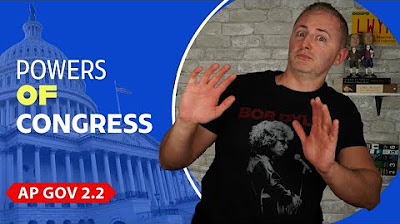Congress.gov: Committee Consideration
Summary
TLDRThe transcript outlines the legislative process within congressional committees, emphasizing the chair's role in setting the agenda. It describes how committees receive numerous bills but can only pursue a limited number in detail. The formal process includes hearings, where witnesses provide feedback, followed by a markup session where members propose amendments. The committee ultimately votes on whether to report the bill, which can either be a revised version or a clean draft. Additionally, it highlights the function of subcommittees in focusing on specific policy areas, noting their limitations in reporting legislation.
Takeaways
- 📜 Committees receive more bills than they can pursue in detail during a Congress.
- 🔍 The committee chair has the primary agenda-setting authority, deciding which bills or issues to pursue.
- 🎤 Hearings serve as the initial formal action on a bill, allowing members and the public to discuss its strengths and weaknesses.
- 🏛️ Key stakeholders, including executive branch agencies and relevant industries, provide input during hearings.
- 📝 Witnesses at hearings submit both oral and written feedback on proposals to inform committee members.
- 🤔 Committee members ask questions to witnesses after their oral statements to gather further insights.
- 🔄 A hearing is not mandatory for a bill to progress within a committee.
- ⚖️ The markup process is a crucial formal step for a bill to advance to the chamber's floor.
- 🔗 Committees may report a bill with recommended changes or introduce a new bill based on the markup process.
- 👥 Subcommittees allow committee members to focus on specific policy areas, but they cannot report legislation to the chamber.
Q & A
What is the primary responsibility of committee chairs in Congress?
-Committee chairs have the chief agenda-setting authority, deciding which bills or issues the committee will pursue through hearings and markups.
What are the steps involved in the legislative process for a bill in a committee?
-The legislative process includes receiving referrals, holding hearings for public feedback, conducting markups to propose amendments, and ultimately voting to report the bill to the chamber.
Why are hearings important in the legislative process?
-Hearings provide a forum for committee members and the public to discuss the strengths and weaknesses of a proposal, allowing selected witnesses to share their insights.
What occurs during a committee markup?
-During a markup, committee members consider changes to a bill by proposing amendments, including the possibility of a complete substitute for the text. The session concludes with a vote on whether to report the bill.
Can a bill advance without a hearing?
-Yes, a hearing is not required for a bill to receive further action from the committee; however, it is a formal way to gather public input.
What is the role of subcommittees in the legislative process?
-Subcommittees focus on specific elements of policy areas but cannot report legislation directly to the chamber; only full committees have that authority.
How does the committee chair decide which bills to advance?
-The committee chair selects proposals based on their perceived importance and likelihood of gaining majority support during markups.
What kind of feedback is solicited during hearings?
-Feedback comes from invited witnesses who provide oral remarks and submit longer written versions of their feedback, which detail their perspectives on the bill.
What does a committee vote during a markup signify?
-A committee vote during a markup signifies agreement by the majority to report the bill, potentially with recommended changes based on adopted amendments.
Are markups commonly held for all proposals?
-No, markups are rarely held unless the proposal is expected to receive majority support, indicating the bill's likelihood of advancement.
Outlines

Dieser Bereich ist nur für Premium-Benutzer verfügbar. Bitte führen Sie ein Upgrade durch, um auf diesen Abschnitt zuzugreifen.
Upgrade durchführenMindmap

Dieser Bereich ist nur für Premium-Benutzer verfügbar. Bitte führen Sie ein Upgrade durch, um auf diesen Abschnitt zuzugreifen.
Upgrade durchführenKeywords

Dieser Bereich ist nur für Premium-Benutzer verfügbar. Bitte führen Sie ein Upgrade durch, um auf diesen Abschnitt zuzugreifen.
Upgrade durchführenHighlights

Dieser Bereich ist nur für Premium-Benutzer verfügbar. Bitte führen Sie ein Upgrade durch, um auf diesen Abschnitt zuzugreifen.
Upgrade durchführenTranscripts

Dieser Bereich ist nur für Premium-Benutzer verfügbar. Bitte führen Sie ein Upgrade durch, um auf diesen Abschnitt zuzugreifen.
Upgrade durchführenWeitere ähnliche Videos ansehen

The Congressional Committee Structure

AP Gov 2.2.1 | Structures, Powers, & Functions of Congress | NEW!

Congressional Committees: Crash Course Government and Politics #7

Policy Agenda Module 1

How a bill becomes a law | US government and civics | US government and civics | Khan Academy

3 Types of Policy Agenda | What is Policy Agenda | How to Set Government Agenda | Public Policy
5.0 / 5 (0 votes)
